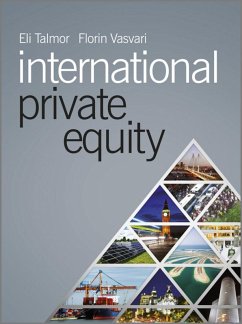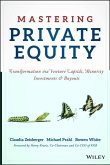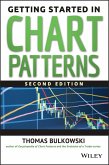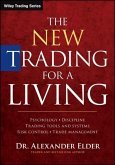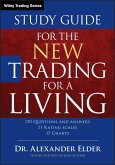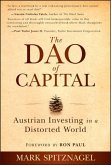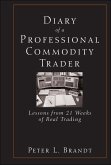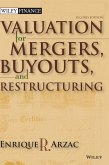- Gebundenes Buch
- Merkliste
- Auf die Merkliste
- Bewerten Bewerten
- Teilen
- Produkt teilen
- Produkterinnerung
- Produkterinnerung
Bringing a unique joint practitioner and academic perspective to the topic, this is the only available text on private equity truly international in focus. Examples are drawn from Europe the Middle East, Africa and America with major case studies from a wide range of business sectors, from the prestigious collection of the London Business School's Coller Institute of Private Equity. Much more than a simple case book, however, International Private Equity provides a valuable overview of the private equity industry and uses the studies to exemplify all stages of the deal process, and to…mehr
Andere Kunden interessierten sich auch für
![Mastering Private Equity Mastering Private Equity]() Claudia ZeisbergerMastering Private Equity69,99 €
Claudia ZeisbergerMastering Private Equity69,99 €![Getting Started in Chart Patterns Getting Started in Chart Patterns]() Thomas N. BulkowskiGetting Started in Chart Patterns28,99 €
Thomas N. BulkowskiGetting Started in Chart Patterns28,99 €![The New Trading for a Living The New Trading for a Living]() Alexander ElderThe New Trading for a Living59,99 €
Alexander ElderThe New Trading for a Living59,99 €![Study Guide for the New Trading for a Living Study Guide for the New Trading for a Living]() Alexander ElderStudy Guide for the New Trading for a Living43,99 €
Alexander ElderStudy Guide for the New Trading for a Living43,99 €![The Dao of Capital The Dao of Capital]() Mark SpitznagelThe Dao of Capital31,99 €
Mark SpitznagelThe Dao of Capital31,99 €![Diary of a Professional Commodity Trader Diary of a Professional Commodity Trader]() Peter L. BrandtDiary of a Professional Commodity Trader40,99 €
Peter L. BrandtDiary of a Professional Commodity Trader40,99 €![Valuation Valuation]() Enrique R. ArzacValuation227,99 €
Enrique R. ArzacValuation227,99 €-
-
-
Bringing a unique joint practitioner and academic perspective to the topic, this is the only available text on private equity truly international in focus. Examples are drawn from Europe the Middle East, Africa and America with major case studies from a wide range of business sectors, from the prestigious collection of the London Business School's Coller Institute of Private Equity. Much more than a simple case book, however, International Private Equity provides a valuable overview of the private equity industry and uses the studies to exemplify all stages of the deal process, and to illustrate such key topics as investing in emerging markets; each chapter guides the reader with an authoritative narrative on the topic treated. Covering all the main aspects of the private equity model, the book includes treatment of fund raising, fund structuring, fund performance measurement, private equity valuation, due diligence, modeling of leveraged buyout transactions, and harvesting of private equity investments.
Hinweis: Dieser Artikel kann nur an eine deutsche Lieferadresse ausgeliefert werden.
Hinweis: Dieser Artikel kann nur an eine deutsche Lieferadresse ausgeliefert werden.
Produktdetails
- Produktdetails
- Wiley Desktop Editions
- Verlag: Wiley & Sons
- 1. Auflage
- Seitenzahl: 764
- Erscheinungstermin: 12. April 2011
- Englisch
- Abmessung: 260mm x 212mm x 47mm
- Gewicht: 1820g
- ISBN-13: 9780470971703
- ISBN-10: 0470971703
- Artikelnr.: 32555520
- Herstellerkennzeichnung
- Libri GmbH
- Europaallee 1
- 36244 Bad Hersfeld
- gpsr@libri.de
- Wiley Desktop Editions
- Verlag: Wiley & Sons
- 1. Auflage
- Seitenzahl: 764
- Erscheinungstermin: 12. April 2011
- Englisch
- Abmessung: 260mm x 212mm x 47mm
- Gewicht: 1820g
- ISBN-13: 9780470971703
- ISBN-10: 0470971703
- Artikelnr.: 32555520
- Herstellerkennzeichnung
- Libri GmbH
- Europaallee 1
- 36244 Bad Hersfeld
- gpsr@libri.de
Eli Talmor is a professor at London Business School and founding Chairman of its Coller Institute of Private Equity. He was previously a professor of finance at the University of California (UCLA and Irvine), Tel Aviv University, and the Wharton School (University of Pennsylvania). Professor Talmor is a seasonal private equity practitioner and has been a director of European and American corporations. He served on the advisory board of the African Venture Capital Association and the Board of Governors of London Business School. He has frequently been invited to deliver keynote speeches to business executives worldwide and interviews to the international media on timely private equity matters. In recent years he has been asked by the U.K. Parliament to provide equity and to advise the U.K. Prime Minister's office. Professor Talmor holds a Ph.D. from the University of North Carolina at Chapel Hill and a B.Sc. from the Technion Israel Institute of Technology. Florin Vasvari is an Assistant Professor of Accounting at London Business School and a fellow of the Coller Institute for Private Equity. He co-teaches the Private Equity School with Professor Talmor, and consults with several organizations. Professor Vasvari is actively pursuing research on private equity topics and debt markets. He has published several articles in top-tier academic journals such as the Journal of Accounting Research and Review of Accounting Studies and has been invited to present his research at top business schools such as Chicago GSB, Columbia Business School, Wharton School, MIT Sloan School of Management, Harvard Business School, INSEAD, and others. He is on the editorial board of Contemporary Accounting Research and the advisory board of the Center for Accounting Research and Education. Professor Vasvari holds a Ph.D. from the University of Toronto, Rotman School of Management and M.A. from the University of Toronto, Department of Economics.
Preface.
Abbreviations.
About the authors.
Part 1 Overview and fund-level analysis.
1 Introduction and overview.
1.1 Introduction.
1.2 Cyclicality of the private equity industry.
1.3 Statistics on the private equity industry.
1.4 Recent regulatory activity.
1.5 The outlook of the private equity industry.
1.6 References.
2 Private equity fund economics.
2.1 Overview.
2.2 Private equity firms or general partners (GPs).
2.3 Investors in private equity funds or limited partners (LPs).
2.4 Private equity funds or limited partnerships.
2.5 Advisors and agents.
2.6 References.
3 Performance measurement in private equity.
3.1 Overview.
3.2 Measures of private equity fund performance.
3.3 Benchmarking private equity performance.
3.4 Academic findings on the performance of private equity funds.
3.5 Why the performance assessment of private equity remains difficult.
3.6 Conclusions.
3.7 References.
4 Private equity investing in emerging markets.
4.1 Introduction.
4.2 Investment landscape.
4.3 Drivers for PE investments in emerging economies.
4.4 Risks of investing in emerging economies.
4.5 Market structure and investment characteristics.
4.6 Comparative landscape of emerging markets.
4.7 Summary.
4.7 References.
5 Fund due diligence.
5.1 What is fund due diligence?
5.2 LP investment process.
5.3 Fund due diligence in detail.
5.4 Summary.
6 Private equity fund accounting.
6.1 What is happening in private equity accounting?
6.2 Current major issues and complexities.
6.3 Interpreting fund accounts.
7 Gatekeepers.
7.1 Introduction.
7.2 Main types of professional advisors.
7.3 In-house or outsourcing?
7.4 Outsourcing to a fund of funds.
7.5 Fund-of-funds economics.
7.6 Selecting a fund of funds.
7.7 Outlook.
7.8 Bibliography.
8 Listed private equity.
8.1 Introduction.
8.2 Benefits and disadvantages of listed private equity.
8.3 Economic and organizational forms.
8.4 Legal forms.
8.5 Estimated risk profile of listed private equity.
8.6 LPE indexes.
8.7 References.
9 Secondary fund transactions.
9.1 Introduction.
9.2 Secondary market development.
9.3 Parties involved in secondary transactions.
9.4 Secondary transactions.
9.5 The pricing of secondary transactions.
9.6 Conclusion.
9.7 References.
Part 2 Deal-level analysis.
10 Valuation of private equity companies.
10.1 Introduction.
10.2 Valuation guidelines.
10.3 Implementation of the main valuation methods: multiples and DCF.
10.4 Pitfalls to be wary of when valuing private companies.
10.A Pueblo Clothing SpA.
10.B Chariot Skates Plc.
10.C References.
11 Deal analysis and due diligence.
11.1 Introduction.
11.2 The sale process.
11.3 Circumstances influence the due diligence process.
11.4 Deal analysis and due diligence during the sale process.
11.5 Motives/Perspectives of stakeholders.
12 Leveraged buyout transactions.
12.1 Introduction.
12.2 LBO execution: The deal process.
12.3 LBO stakeholders.
12.4 Value creation in an LBO.
12.5 References.
13 Leveraged buyout modeling: An Excel application.
13.1 Overview.
13.2 Build a pre-transaction structure model.
13.3 Determine transaction structure: Uses of funds.
13.4 Determine transaction structure: Sources of funds.
13.5 Build a post-transaction structure model.
13.6 Determine exit and compute returns.
13.7 Optimization and analysis of the LBO model.
13.8 Analysis of the Toys R Us LBO.
13.9 Reference.
14 Post-deal operational improvements.
14.1 What operational improvements are made post deal?
14.2 Identifying the opportunity.
14.3 EBITDA growth.
14.4 Maximizing assets-human capital.
14.5 When things go wrong.
14.6 Conclusion.
14.7 References.
15 Harvesting private equity investments.
15.1 Introduction.
15.2 Steps to exiting a private equity investment.
15.3 Exit strategies.
15.4 Summary.
15.5 References.
Part 3 Early-stage investing.
16 Angel investing.
16.1 What is angel investing?
16.2 What motivates business angels?
16.3 Angel investment process.
16.4 Recent developments and trends.
16.5 Summary.
16.6 References.
17 Venture capital.
17.1 Introduction.
17.2 What is venture capital.
17.3 The VC investment process.
17.4 The VC contract.
17.5 Alternative sources of VC financing.
17.6 Conclusion.
17.7 References.
Part 4 Case studies.
18 Realza Capital.
December 2006.
December 2008.
19 Swicorp: Private equity in the MENA region 2009.
Swicorp-A Short History.
The MENA region.
The MENA Private Equity Landscape.
The role of sovereign wealth funds (SWFs).
Swicorp's Intaj Investment Strategy.
Deal selection process.
Step Carpet Group.
Jordan Aviation LLC.
20 Founding Mekong Capital.
Vietnam and the private equity industry.
MEF I and the initial investment philosophy.
MEF I case study: AA Corporation.
MEF II and a new investment philosophy.
MEF II case study: International Consumer Products.
Vietnam Azalea Fund.
2007-searching for answers from within.
The corporate transformation process.
Will it work?
21 Bloomsbury Capital: June 2007.
22 Edcon: Going shopping in South Africa.
Edcon: A Leading South African Retailer.
Bain Capital: Background.
Opportunity Knocks.
South Africa.
Currency risk.
The deal.
The bid.
23 FiberNet Communications.
Hungarian history and economy.
Hungarian television broadcasting market.
Cable TV industry.
FiberNet's key competitors.
The FiberNet opportunity.
24 Seat SpA.
Chronology of Seat transaction.
Bain Capital: background.
The global and European directory market.
The Italian directory market.
Seat business description.
Market entry of Pagine Utili.
The Internet: Threat or opportunity?
Due diligence.
Italian economic and political landscape.
Privatization process in Italy.
The deal.
25 Ducati and Investindustrial: Racing out of the pits and over the finish
line.
Investindustrial acquisition of Ducati.
Improving the company (2006-2008).
The world motorcycle industry in 2008.
Raising a new fund.
A "wild ride" for Ducati's stock.
June 2010.
26 Styles & Wood: Behind the scenes of retail.
Styles & Wood: The history.
Gerard Quiligotti and the turnaround years.
The MBO: The fall of Wembley Stadium Group.
Styles & Wood since 1996: Managing the growth strategy.
Project Oak in 2001: Management incentives and reaping rewards.
Project Oval in 2004: From 3i to Aberdeen-secondary buyout decision.
Market and competition.
Investing decision.
27 SunRay Renewable Energy: Private equity in the sunshine.
SunRay's choice of solar technology.
The value chain of a solar PV developer.
The European renewable market in 2006-2008.
SunRay's business model.
Building the management team.
Learning the solar PV game the hard way.
Scaling up the business across Southern Europe.
Under the umbrella of private equity.
Montalto di Castro: Building the largest solar power park in Europe.
The decision to exit.
SunRay's spirit still alive.
28 Debenhams.
Post deal and going public again.
29 Optos: A sight worth seeing.
Douglas Anderson and the vision.
Scottish business landscape and funding for early-stage startups.
Product development.
Diseases of the back of the eye and Optos's target market.
Manufacturing.
Competition.
Business model: The "razor/razor blade" concept.
Profit and loss implications.
Cash flow implications.
Financing 1995-2001.
Geographic expansion.
Financing in 2002.
30 Capital for Enterprise U.K.: Bridging the SME early-stage finance gap.
An "equity gap"?
Previous attempts by the U.K. government to tackle the "equity gap".
Limits of previous programs.
Launching enterprise capital funds.
Key questions and options for the ECF program design.
The first years of operation of the ECF program.
A few years on: A first assessment.
Where next?
Glossary.
Index.
Abbreviations.
About the authors.
Part 1 Overview and fund-level analysis.
1 Introduction and overview.
1.1 Introduction.
1.2 Cyclicality of the private equity industry.
1.3 Statistics on the private equity industry.
1.4 Recent regulatory activity.
1.5 The outlook of the private equity industry.
1.6 References.
2 Private equity fund economics.
2.1 Overview.
2.2 Private equity firms or general partners (GPs).
2.3 Investors in private equity funds or limited partners (LPs).
2.4 Private equity funds or limited partnerships.
2.5 Advisors and agents.
2.6 References.
3 Performance measurement in private equity.
3.1 Overview.
3.2 Measures of private equity fund performance.
3.3 Benchmarking private equity performance.
3.4 Academic findings on the performance of private equity funds.
3.5 Why the performance assessment of private equity remains difficult.
3.6 Conclusions.
3.7 References.
4 Private equity investing in emerging markets.
4.1 Introduction.
4.2 Investment landscape.
4.3 Drivers for PE investments in emerging economies.
4.4 Risks of investing in emerging economies.
4.5 Market structure and investment characteristics.
4.6 Comparative landscape of emerging markets.
4.7 Summary.
4.7 References.
5 Fund due diligence.
5.1 What is fund due diligence?
5.2 LP investment process.
5.3 Fund due diligence in detail.
5.4 Summary.
6 Private equity fund accounting.
6.1 What is happening in private equity accounting?
6.2 Current major issues and complexities.
6.3 Interpreting fund accounts.
7 Gatekeepers.
7.1 Introduction.
7.2 Main types of professional advisors.
7.3 In-house or outsourcing?
7.4 Outsourcing to a fund of funds.
7.5 Fund-of-funds economics.
7.6 Selecting a fund of funds.
7.7 Outlook.
7.8 Bibliography.
8 Listed private equity.
8.1 Introduction.
8.2 Benefits and disadvantages of listed private equity.
8.3 Economic and organizational forms.
8.4 Legal forms.
8.5 Estimated risk profile of listed private equity.
8.6 LPE indexes.
8.7 References.
9 Secondary fund transactions.
9.1 Introduction.
9.2 Secondary market development.
9.3 Parties involved in secondary transactions.
9.4 Secondary transactions.
9.5 The pricing of secondary transactions.
9.6 Conclusion.
9.7 References.
Part 2 Deal-level analysis.
10 Valuation of private equity companies.
10.1 Introduction.
10.2 Valuation guidelines.
10.3 Implementation of the main valuation methods: multiples and DCF.
10.4 Pitfalls to be wary of when valuing private companies.
10.A Pueblo Clothing SpA.
10.B Chariot Skates Plc.
10.C References.
11 Deal analysis and due diligence.
11.1 Introduction.
11.2 The sale process.
11.3 Circumstances influence the due diligence process.
11.4 Deal analysis and due diligence during the sale process.
11.5 Motives/Perspectives of stakeholders.
12 Leveraged buyout transactions.
12.1 Introduction.
12.2 LBO execution: The deal process.
12.3 LBO stakeholders.
12.4 Value creation in an LBO.
12.5 References.
13 Leveraged buyout modeling: An Excel application.
13.1 Overview.
13.2 Build a pre-transaction structure model.
13.3 Determine transaction structure: Uses of funds.
13.4 Determine transaction structure: Sources of funds.
13.5 Build a post-transaction structure model.
13.6 Determine exit and compute returns.
13.7 Optimization and analysis of the LBO model.
13.8 Analysis of the Toys R Us LBO.
13.9 Reference.
14 Post-deal operational improvements.
14.1 What operational improvements are made post deal?
14.2 Identifying the opportunity.
14.3 EBITDA growth.
14.4 Maximizing assets-human capital.
14.5 When things go wrong.
14.6 Conclusion.
14.7 References.
15 Harvesting private equity investments.
15.1 Introduction.
15.2 Steps to exiting a private equity investment.
15.3 Exit strategies.
15.4 Summary.
15.5 References.
Part 3 Early-stage investing.
16 Angel investing.
16.1 What is angel investing?
16.2 What motivates business angels?
16.3 Angel investment process.
16.4 Recent developments and trends.
16.5 Summary.
16.6 References.
17 Venture capital.
17.1 Introduction.
17.2 What is venture capital.
17.3 The VC investment process.
17.4 The VC contract.
17.5 Alternative sources of VC financing.
17.6 Conclusion.
17.7 References.
Part 4 Case studies.
18 Realza Capital.
December 2006.
December 2008.
19 Swicorp: Private equity in the MENA region 2009.
Swicorp-A Short History.
The MENA region.
The MENA Private Equity Landscape.
The role of sovereign wealth funds (SWFs).
Swicorp's Intaj Investment Strategy.
Deal selection process.
Step Carpet Group.
Jordan Aviation LLC.
20 Founding Mekong Capital.
Vietnam and the private equity industry.
MEF I and the initial investment philosophy.
MEF I case study: AA Corporation.
MEF II and a new investment philosophy.
MEF II case study: International Consumer Products.
Vietnam Azalea Fund.
2007-searching for answers from within.
The corporate transformation process.
Will it work?
21 Bloomsbury Capital: June 2007.
22 Edcon: Going shopping in South Africa.
Edcon: A Leading South African Retailer.
Bain Capital: Background.
Opportunity Knocks.
South Africa.
Currency risk.
The deal.
The bid.
23 FiberNet Communications.
Hungarian history and economy.
Hungarian television broadcasting market.
Cable TV industry.
FiberNet's key competitors.
The FiberNet opportunity.
24 Seat SpA.
Chronology of Seat transaction.
Bain Capital: background.
The global and European directory market.
The Italian directory market.
Seat business description.
Market entry of Pagine Utili.
The Internet: Threat or opportunity?
Due diligence.
Italian economic and political landscape.
Privatization process in Italy.
The deal.
25 Ducati and Investindustrial: Racing out of the pits and over the finish
line.
Investindustrial acquisition of Ducati.
Improving the company (2006-2008).
The world motorcycle industry in 2008.
Raising a new fund.
A "wild ride" for Ducati's stock.
June 2010.
26 Styles & Wood: Behind the scenes of retail.
Styles & Wood: The history.
Gerard Quiligotti and the turnaround years.
The MBO: The fall of Wembley Stadium Group.
Styles & Wood since 1996: Managing the growth strategy.
Project Oak in 2001: Management incentives and reaping rewards.
Project Oval in 2004: From 3i to Aberdeen-secondary buyout decision.
Market and competition.
Investing decision.
27 SunRay Renewable Energy: Private equity in the sunshine.
SunRay's choice of solar technology.
The value chain of a solar PV developer.
The European renewable market in 2006-2008.
SunRay's business model.
Building the management team.
Learning the solar PV game the hard way.
Scaling up the business across Southern Europe.
Under the umbrella of private equity.
Montalto di Castro: Building the largest solar power park in Europe.
The decision to exit.
SunRay's spirit still alive.
28 Debenhams.
Post deal and going public again.
29 Optos: A sight worth seeing.
Douglas Anderson and the vision.
Scottish business landscape and funding for early-stage startups.
Product development.
Diseases of the back of the eye and Optos's target market.
Manufacturing.
Competition.
Business model: The "razor/razor blade" concept.
Profit and loss implications.
Cash flow implications.
Financing 1995-2001.
Geographic expansion.
Financing in 2002.
30 Capital for Enterprise U.K.: Bridging the SME early-stage finance gap.
An "equity gap"?
Previous attempts by the U.K. government to tackle the "equity gap".
Limits of previous programs.
Launching enterprise capital funds.
Key questions and options for the ECF program design.
The first years of operation of the ECF program.
A few years on: A first assessment.
Where next?
Glossary.
Index.
Preface.
Abbreviations.
About the authors.
Part 1 Overview and fund-level analysis.
1 Introduction and overview.
1.1 Introduction.
1.2 Cyclicality of the private equity industry.
1.3 Statistics on the private equity industry.
1.4 Recent regulatory activity.
1.5 The outlook of the private equity industry.
1.6 References.
2 Private equity fund economics.
2.1 Overview.
2.2 Private equity firms or general partners (GPs).
2.3 Investors in private equity funds or limited partners (LPs).
2.4 Private equity funds or limited partnerships.
2.5 Advisors and agents.
2.6 References.
3 Performance measurement in private equity.
3.1 Overview.
3.2 Measures of private equity fund performance.
3.3 Benchmarking private equity performance.
3.4 Academic findings on the performance of private equity funds.
3.5 Why the performance assessment of private equity remains difficult.
3.6 Conclusions.
3.7 References.
4 Private equity investing in emerging markets.
4.1 Introduction.
4.2 Investment landscape.
4.3 Drivers for PE investments in emerging economies.
4.4 Risks of investing in emerging economies.
4.5 Market structure and investment characteristics.
4.6 Comparative landscape of emerging markets.
4.7 Summary.
4.7 References.
5 Fund due diligence.
5.1 What is fund due diligence?
5.2 LP investment process.
5.3 Fund due diligence in detail.
5.4 Summary.
6 Private equity fund accounting.
6.1 What is happening in private equity accounting?
6.2 Current major issues and complexities.
6.3 Interpreting fund accounts.
7 Gatekeepers.
7.1 Introduction.
7.2 Main types of professional advisors.
7.3 In-house or outsourcing?
7.4 Outsourcing to a fund of funds.
7.5 Fund-of-funds economics.
7.6 Selecting a fund of funds.
7.7 Outlook.
7.8 Bibliography.
8 Listed private equity.
8.1 Introduction.
8.2 Benefits and disadvantages of listed private equity.
8.3 Economic and organizational forms.
8.4 Legal forms.
8.5 Estimated risk profile of listed private equity.
8.6 LPE indexes.
8.7 References.
9 Secondary fund transactions.
9.1 Introduction.
9.2 Secondary market development.
9.3 Parties involved in secondary transactions.
9.4 Secondary transactions.
9.5 The pricing of secondary transactions.
9.6 Conclusion.
9.7 References.
Part 2 Deal-level analysis.
10 Valuation of private equity companies.
10.1 Introduction.
10.2 Valuation guidelines.
10.3 Implementation of the main valuation methods: multiples and DCF.
10.4 Pitfalls to be wary of when valuing private companies.
10.A Pueblo Clothing SpA.
10.B Chariot Skates Plc.
10.C References.
11 Deal analysis and due diligence.
11.1 Introduction.
11.2 The sale process.
11.3 Circumstances influence the due diligence process.
11.4 Deal analysis and due diligence during the sale process.
11.5 Motives/Perspectives of stakeholders.
12 Leveraged buyout transactions.
12.1 Introduction.
12.2 LBO execution: The deal process.
12.3 LBO stakeholders.
12.4 Value creation in an LBO.
12.5 References.
13 Leveraged buyout modeling: An Excel application.
13.1 Overview.
13.2 Build a pre-transaction structure model.
13.3 Determine transaction structure: Uses of funds.
13.4 Determine transaction structure: Sources of funds.
13.5 Build a post-transaction structure model.
13.6 Determine exit and compute returns.
13.7 Optimization and analysis of the LBO model.
13.8 Analysis of the Toys R Us LBO.
13.9 Reference.
14 Post-deal operational improvements.
14.1 What operational improvements are made post deal?
14.2 Identifying the opportunity.
14.3 EBITDA growth.
14.4 Maximizing assets-human capital.
14.5 When things go wrong.
14.6 Conclusion.
14.7 References.
15 Harvesting private equity investments.
15.1 Introduction.
15.2 Steps to exiting a private equity investment.
15.3 Exit strategies.
15.4 Summary.
15.5 References.
Part 3 Early-stage investing.
16 Angel investing.
16.1 What is angel investing?
16.2 What motivates business angels?
16.3 Angel investment process.
16.4 Recent developments and trends.
16.5 Summary.
16.6 References.
17 Venture capital.
17.1 Introduction.
17.2 What is venture capital.
17.3 The VC investment process.
17.4 The VC contract.
17.5 Alternative sources of VC financing.
17.6 Conclusion.
17.7 References.
Part 4 Case studies.
18 Realza Capital.
December 2006.
December 2008.
19 Swicorp: Private equity in the MENA region 2009.
Swicorp-A Short History.
The MENA region.
The MENA Private Equity Landscape.
The role of sovereign wealth funds (SWFs).
Swicorp's Intaj Investment Strategy.
Deal selection process.
Step Carpet Group.
Jordan Aviation LLC.
20 Founding Mekong Capital.
Vietnam and the private equity industry.
MEF I and the initial investment philosophy.
MEF I case study: AA Corporation.
MEF II and a new investment philosophy.
MEF II case study: International Consumer Products.
Vietnam Azalea Fund.
2007-searching for answers from within.
The corporate transformation process.
Will it work?
21 Bloomsbury Capital: June 2007.
22 Edcon: Going shopping in South Africa.
Edcon: A Leading South African Retailer.
Bain Capital: Background.
Opportunity Knocks.
South Africa.
Currency risk.
The deal.
The bid.
23 FiberNet Communications.
Hungarian history and economy.
Hungarian television broadcasting market.
Cable TV industry.
FiberNet's key competitors.
The FiberNet opportunity.
24 Seat SpA.
Chronology of Seat transaction.
Bain Capital: background.
The global and European directory market.
The Italian directory market.
Seat business description.
Market entry of Pagine Utili.
The Internet: Threat or opportunity?
Due diligence.
Italian economic and political landscape.
Privatization process in Italy.
The deal.
25 Ducati and Investindustrial: Racing out of the pits and over the finish
line.
Investindustrial acquisition of Ducati.
Improving the company (2006-2008).
The world motorcycle industry in 2008.
Raising a new fund.
A "wild ride" for Ducati's stock.
June 2010.
26 Styles & Wood: Behind the scenes of retail.
Styles & Wood: The history.
Gerard Quiligotti and the turnaround years.
The MBO: The fall of Wembley Stadium Group.
Styles & Wood since 1996: Managing the growth strategy.
Project Oak in 2001: Management incentives and reaping rewards.
Project Oval in 2004: From 3i to Aberdeen-secondary buyout decision.
Market and competition.
Investing decision.
27 SunRay Renewable Energy: Private equity in the sunshine.
SunRay's choice of solar technology.
The value chain of a solar PV developer.
The European renewable market in 2006-2008.
SunRay's business model.
Building the management team.
Learning the solar PV game the hard way.
Scaling up the business across Southern Europe.
Under the umbrella of private equity.
Montalto di Castro: Building the largest solar power park in Europe.
The decision to exit.
SunRay's spirit still alive.
28 Debenhams.
Post deal and going public again.
29 Optos: A sight worth seeing.
Douglas Anderson and the vision.
Scottish business landscape and funding for early-stage startups.
Product development.
Diseases of the back of the eye and Optos's target market.
Manufacturing.
Competition.
Business model: The "razor/razor blade" concept.
Profit and loss implications.
Cash flow implications.
Financing 1995-2001.
Geographic expansion.
Financing in 2002.
30 Capital for Enterprise U.K.: Bridging the SME early-stage finance gap.
An "equity gap"?
Previous attempts by the U.K. government to tackle the "equity gap".
Limits of previous programs.
Launching enterprise capital funds.
Key questions and options for the ECF program design.
The first years of operation of the ECF program.
A few years on: A first assessment.
Where next?
Glossary.
Index.
Abbreviations.
About the authors.
Part 1 Overview and fund-level analysis.
1 Introduction and overview.
1.1 Introduction.
1.2 Cyclicality of the private equity industry.
1.3 Statistics on the private equity industry.
1.4 Recent regulatory activity.
1.5 The outlook of the private equity industry.
1.6 References.
2 Private equity fund economics.
2.1 Overview.
2.2 Private equity firms or general partners (GPs).
2.3 Investors in private equity funds or limited partners (LPs).
2.4 Private equity funds or limited partnerships.
2.5 Advisors and agents.
2.6 References.
3 Performance measurement in private equity.
3.1 Overview.
3.2 Measures of private equity fund performance.
3.3 Benchmarking private equity performance.
3.4 Academic findings on the performance of private equity funds.
3.5 Why the performance assessment of private equity remains difficult.
3.6 Conclusions.
3.7 References.
4 Private equity investing in emerging markets.
4.1 Introduction.
4.2 Investment landscape.
4.3 Drivers for PE investments in emerging economies.
4.4 Risks of investing in emerging economies.
4.5 Market structure and investment characteristics.
4.6 Comparative landscape of emerging markets.
4.7 Summary.
4.7 References.
5 Fund due diligence.
5.1 What is fund due diligence?
5.2 LP investment process.
5.3 Fund due diligence in detail.
5.4 Summary.
6 Private equity fund accounting.
6.1 What is happening in private equity accounting?
6.2 Current major issues and complexities.
6.3 Interpreting fund accounts.
7 Gatekeepers.
7.1 Introduction.
7.2 Main types of professional advisors.
7.3 In-house or outsourcing?
7.4 Outsourcing to a fund of funds.
7.5 Fund-of-funds economics.
7.6 Selecting a fund of funds.
7.7 Outlook.
7.8 Bibliography.
8 Listed private equity.
8.1 Introduction.
8.2 Benefits and disadvantages of listed private equity.
8.3 Economic and organizational forms.
8.4 Legal forms.
8.5 Estimated risk profile of listed private equity.
8.6 LPE indexes.
8.7 References.
9 Secondary fund transactions.
9.1 Introduction.
9.2 Secondary market development.
9.3 Parties involved in secondary transactions.
9.4 Secondary transactions.
9.5 The pricing of secondary transactions.
9.6 Conclusion.
9.7 References.
Part 2 Deal-level analysis.
10 Valuation of private equity companies.
10.1 Introduction.
10.2 Valuation guidelines.
10.3 Implementation of the main valuation methods: multiples and DCF.
10.4 Pitfalls to be wary of when valuing private companies.
10.A Pueblo Clothing SpA.
10.B Chariot Skates Plc.
10.C References.
11 Deal analysis and due diligence.
11.1 Introduction.
11.2 The sale process.
11.3 Circumstances influence the due diligence process.
11.4 Deal analysis and due diligence during the sale process.
11.5 Motives/Perspectives of stakeholders.
12 Leveraged buyout transactions.
12.1 Introduction.
12.2 LBO execution: The deal process.
12.3 LBO stakeholders.
12.4 Value creation in an LBO.
12.5 References.
13 Leveraged buyout modeling: An Excel application.
13.1 Overview.
13.2 Build a pre-transaction structure model.
13.3 Determine transaction structure: Uses of funds.
13.4 Determine transaction structure: Sources of funds.
13.5 Build a post-transaction structure model.
13.6 Determine exit and compute returns.
13.7 Optimization and analysis of the LBO model.
13.8 Analysis of the Toys R Us LBO.
13.9 Reference.
14 Post-deal operational improvements.
14.1 What operational improvements are made post deal?
14.2 Identifying the opportunity.
14.3 EBITDA growth.
14.4 Maximizing assets-human capital.
14.5 When things go wrong.
14.6 Conclusion.
14.7 References.
15 Harvesting private equity investments.
15.1 Introduction.
15.2 Steps to exiting a private equity investment.
15.3 Exit strategies.
15.4 Summary.
15.5 References.
Part 3 Early-stage investing.
16 Angel investing.
16.1 What is angel investing?
16.2 What motivates business angels?
16.3 Angel investment process.
16.4 Recent developments and trends.
16.5 Summary.
16.6 References.
17 Venture capital.
17.1 Introduction.
17.2 What is venture capital.
17.3 The VC investment process.
17.4 The VC contract.
17.5 Alternative sources of VC financing.
17.6 Conclusion.
17.7 References.
Part 4 Case studies.
18 Realza Capital.
December 2006.
December 2008.
19 Swicorp: Private equity in the MENA region 2009.
Swicorp-A Short History.
The MENA region.
The MENA Private Equity Landscape.
The role of sovereign wealth funds (SWFs).
Swicorp's Intaj Investment Strategy.
Deal selection process.
Step Carpet Group.
Jordan Aviation LLC.
20 Founding Mekong Capital.
Vietnam and the private equity industry.
MEF I and the initial investment philosophy.
MEF I case study: AA Corporation.
MEF II and a new investment philosophy.
MEF II case study: International Consumer Products.
Vietnam Azalea Fund.
2007-searching for answers from within.
The corporate transformation process.
Will it work?
21 Bloomsbury Capital: June 2007.
22 Edcon: Going shopping in South Africa.
Edcon: A Leading South African Retailer.
Bain Capital: Background.
Opportunity Knocks.
South Africa.
Currency risk.
The deal.
The bid.
23 FiberNet Communications.
Hungarian history and economy.
Hungarian television broadcasting market.
Cable TV industry.
FiberNet's key competitors.
The FiberNet opportunity.
24 Seat SpA.
Chronology of Seat transaction.
Bain Capital: background.
The global and European directory market.
The Italian directory market.
Seat business description.
Market entry of Pagine Utili.
The Internet: Threat or opportunity?
Due diligence.
Italian economic and political landscape.
Privatization process in Italy.
The deal.
25 Ducati and Investindustrial: Racing out of the pits and over the finish
line.
Investindustrial acquisition of Ducati.
Improving the company (2006-2008).
The world motorcycle industry in 2008.
Raising a new fund.
A "wild ride" for Ducati's stock.
June 2010.
26 Styles & Wood: Behind the scenes of retail.
Styles & Wood: The history.
Gerard Quiligotti and the turnaround years.
The MBO: The fall of Wembley Stadium Group.
Styles & Wood since 1996: Managing the growth strategy.
Project Oak in 2001: Management incentives and reaping rewards.
Project Oval in 2004: From 3i to Aberdeen-secondary buyout decision.
Market and competition.
Investing decision.
27 SunRay Renewable Energy: Private equity in the sunshine.
SunRay's choice of solar technology.
The value chain of a solar PV developer.
The European renewable market in 2006-2008.
SunRay's business model.
Building the management team.
Learning the solar PV game the hard way.
Scaling up the business across Southern Europe.
Under the umbrella of private equity.
Montalto di Castro: Building the largest solar power park in Europe.
The decision to exit.
SunRay's spirit still alive.
28 Debenhams.
Post deal and going public again.
29 Optos: A sight worth seeing.
Douglas Anderson and the vision.
Scottish business landscape and funding for early-stage startups.
Product development.
Diseases of the back of the eye and Optos's target market.
Manufacturing.
Competition.
Business model: The "razor/razor blade" concept.
Profit and loss implications.
Cash flow implications.
Financing 1995-2001.
Geographic expansion.
Financing in 2002.
30 Capital for Enterprise U.K.: Bridging the SME early-stage finance gap.
An "equity gap"?
Previous attempts by the U.K. government to tackle the "equity gap".
Limits of previous programs.
Launching enterprise capital funds.
Key questions and options for the ECF program design.
The first years of operation of the ECF program.
A few years on: A first assessment.
Where next?
Glossary.
Index.

